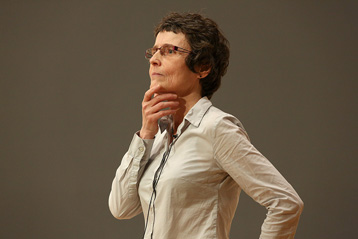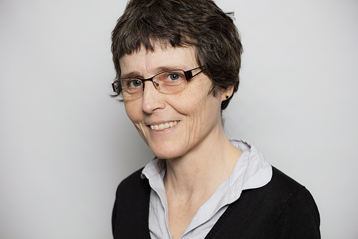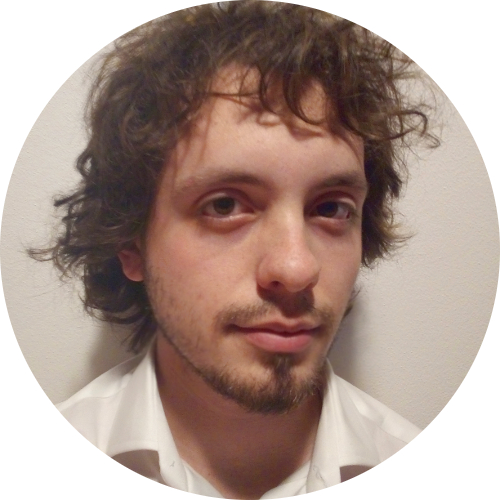by/di Emanuele Tron
![]() English version below / Vai alla versione italiana
English version below / Vai alla versione italiana

© Patrick Imbert/Collège de France
Mathematical research is a highly challenging activity: tales of reclusive work routines and sleepless nights are not uncommon among mathematicians, nor are difficulties in conjugating hard work and family life. Claire Voisin faced those as well, but, a CNRS Gold Medal and five children later, she surely did pretty well for herself.
Born in 1962 in Saint-Leu-la-forêt, a French town near Paris, in a large family (having eight sisters and three brothers, nine of them older than her), she got to experience maths quite early on: her father, an engineer with a burning love for Euclidean geometry, supplied her with maths books during high school. Mathematics was never her only pursuit: her mother made her acquantained with visual arts, and philosophy and poetry were (and still are to this day) among her hobbies as well; only before graduation did her interest and enjoyment become a true passion, at which point she decided that maths was going to be her job.
After leaving home at 17 thanks to a scholarship and studying at the École Normale Supérieure, she undertook a Ph.D. under the supervision of Arnaud Beauville, and already stood out from the beginning; "She has always been very talented," Beauville recalls. After that, her rise to prominence in the field of complex algebraic geometry progressed steadily, although she contradicted the stereotype of mathematics as a young people's game by publishing many important results at a relatively late age–and now, at 55, she is more active than ever. It is not always easy: for instance, she admits that throughout her life, she has always found it difficult to bear the frustration of not being able to do mathematics at her best, even after thirty years of it. Despite this, her achievements rank among the most outstanding: an EMS prize in 1992, a Clay Research Award in 2008, a CNRS Gold Medal in 2016 (one of the only six mathematicians to ever be awarded such a prize, together with the equally illustrious Émile Borel, Jacques Hadamard, Henri Cartan, Jean-Pierre Serre, and Alain Connes, and the first woman among those), the Shaw Prize in 2017, as well as the membership of the Académie des Sciences, the Accademia Nazionale dei Lincei, and the London Mathematical Society, and plenary lectures at the European Congress of Mathematics in Stockholm and the International Congress of Mathematicians in Hyderabad.
Another stereotype, that of women in general as bound to family life over career (thus limiting their career progress in mathematics), could not be less true in her case: she always managed to keep balance between the two thanks to "the excellent child care system in France" and the help of her husband who, being in turn a mathematician, could understand her needs very well; this even helped her put things in perspective, so much so that she acknowledges she would have had much more psychological difficulty in her research if she had not had her family.
Voisin is best known for her work in Hodge theory. This branch of mathematics concerns the study of complex algebraic varieties: these are sets of points defined by algebraic equations over the complex numbers; by attaching to them some spaces (such as the "cohomology groups" of the varieties), which are analysed by means of complex algebraic geometry, it draws conclusions about the geometry of the varieties. The famous Hodge conjecture, one of the seven Clay Millennium Prize Problems, roughly speaking tells which elements of the cohomology come from algebraic varieties inside the original one. A 2002 result of Voisin shows that the generalisation of this conjecture to the class of so-called Kähler manifolds is false, thus proving that if it is true, it is narrowly so, in a sense. The two theorems she is most proud of are, in her words, the proof of Green's canonical syzygy conjecture and the construction of compact Kähler manifolds not homotopically equivalent to projective manifolds. With such a level of abstraction in her everyday work, and all the difficulties that mathematicians are faced with, even first-class ones like her, she still has not forgotten what the beginnings were like and how it feels. "Mathematics is a very demanding activity and I would advise a student to pursue a research career only if very motivated. But the reward is huge."
If you want to know more about Claire Voisin, you can read the following article or check this video (in French).
![]() Versione italiana a seguire / Back to English
Versione italiana a seguire / Back to English

© Patrick Imbert/Collège de France
Fare ricerca matematica è un’attività molto impegnativa: non è raro sentire, tra i matematici, storie di notti insonni e lavoro solitario, né sono poche le difficoltà nello sposare il lavoro e la famiglia. Anche Claire Voisin ha dovuto affrontare questi ostacoli ma, con una medaglia d’oro del CNRS e cinque figli all’attivo, non si può dire che non li abbia superati elegantemente.
Nata nel 1962 a Saint-Leu-la-forêt, una cittadina francese nei pressi di Parigi, in una famiglia numerosa (comprendente nove figlie e tre figli, dei quali nove più vecchi di Claire) ebbe avuto già da giovane la possibilità di avvicinarsi alla matematica: suo padre, un ingegnere profondamente innamorato della geometria euclidea, la rifornì di libri di matematica durante gli anni della scuola superiore. La matematica, tuttavia, non è mai stata il suo unico interesse: sua madre le fece scoprire le arti visive e filosofia e poesia sono sempre stati (e rimangono tuttora) due dei suoi passatempo. Solamente al momento di laurearsi il suo interesse e il suo diletto diventarono una vera e propria passione, spingendola a decidere che la matematica sarebbe stato il suo mestiere.
Dopo aver lasciato casa a 17 anni grazie ad una borsa di studio e aver studiato all’École Normale Supérieure, iniziò un dottorato, sotto la supervisione di Arnaud Beauville, facendosi notare fin dai primi giorni: “È sempre stata molto talentuosa”, ricorda Beauville. Dopo questo, la sua ascesa nel campo della geometria algebrica complessa è continuata con costanza anche se, contraddicendo lo stereotipo della matematica come un’attività da giovani, ha pubblicato molti risultati importanti ad un’età avanzata (relativamente parlando) ed oggi, a 55 anni, è più attiva che mai. Non che sia sempre stato facile: ad esempio lei stessa ammette che in ogni momento della sua vita ha trovato difficile sopportare la frustrazione di non riuscire a fare matematica come vorrebbe, anche dopo 30 anni di carriera. Ciò nonostante i suoi successi sono decisamente straordinari: un premio dell’EMS nel 1992, un Clay Research Award nel 2008, una medaglia d’oro del CNRS nel 2016 (prima di lei solo cinque matematici, tra cui nessuna donna, l’avevano ricevuta, tutti eminentissimi: Émile Borel, Jacques Hadamard, Henri Cartan, Jean-Pierre Serre e Alain Connes), e il Shaw Prize nel 2017. Oltre a questo è membro dell’Académie des Sciences, dell’Accademia Nazionale dei Lincei e della London Mathematical Society ed ha tenuto conferenze plenarie al Congresso Europeo di Matematica a Stoccolma e al Congresso Internazionale dei Matematici a Hyderabad.
Un altro stereotipo, quello che vede le donne più legate alla vita domestica e familiare rispetto al lavoro, rallentando pertanto l’avanzamento di carriera in matematica, non potrebbe trovare un controesempio migliore che in lei: è sempre riuscita a mantenere l’equilibrio tra i due mondi, grazie “all’eccellente sistema francese di assistenza all’infanzia” e all’aiuto del marito che, matematico a sua volta, è sempre stato in grado di capire le necessità della moglie. Questa parte della sua vita l'ha aiutata a vedere le cose nella giusta prospettiva-tanto da riconoscere che avrebbe avuto molti più ostacoli psicologici nella sua ricerca senza la propria famiglia.
I lavori più noti di Voisin sono in teoria di Hodge. Questa branca della matematica si occupa dello studio delle varietà algebriche complesse: ossia, insiemi di punti definiti da equazioni algebriche nei numeri complessi; associando loro certi spazi (come ad esempio i “gruppi di coomologia” delle varietà), che vengono analizzati con gli strumenti della geometria algebrica complessa, trae conclusioni sulla geometria delle varietà. La famosa congettura di Hodge, uno dei sette Problemi del Millennio dell’istituto Clay, grosso modo determina quali elementi della coomologia provengono da varietà algebriche all’interno della varietà originaria. Un risultato di Voisin del 2002 mostra come la generalizzazione di questa congettura alla classe delle cosiddette varietà di Kähler è falsa, mostrando quindi che se è vera, in un certo senso, lo è di poco. I due teoremi di cui è più fiera sono, dice lei, la dimostrazione della congettura di Green sulle sizigie canoniche e la costruzione di varietà di Kähler compatte non omotopicamente equivalenti a varietà proiettive. Anche con un tale livello di astrazione nel suo lavoro quotidiano, e tutte le difficoltà che devono affrontare i matematici, anche quelli di prim’ordine, non ha ancora dimenticato come ci si sente agli inizi. “La matematica è un’attività molto impegnativa e consiglierei a una studentessa di intraprendere una carriera nella ricerca solo se molto motivata. Ma la ricompensa è enorme.”
Se siete curiosi di scoprire qualcosa in più su Claire Voisin, potete leggere questo articolo (in inglese), quest'altro articolo (in italiano) o guardare video (in francese).
 Emanuele is a Master's student in Diophantine geometry at the Institut de Mathématiques in Bordeaux. His first contest in the Italian Mathematical Olympiads took him by surprise, but made him love the world of mathematics. He has been regularly creating Olympiad problems after high school as a means to appreciate elementary facts and offer others the chance to discover mathematics. In his free time he is an avid reader of literature and philosophy, does mountaineering, and enjoys learning to play new instruments.
Emanuele is a Master's student in Diophantine geometry at the Institut de Mathématiques in Bordeaux. His first contest in the Italian Mathematical Olympiads took him by surprise, but made him love the world of mathematics. He has been regularly creating Olympiad problems after high school as a means to appreciate elementary facts and offer others the chance to discover mathematics. In his free time he is an avid reader of literature and philosophy, does mountaineering, and enjoys learning to play new instruments.